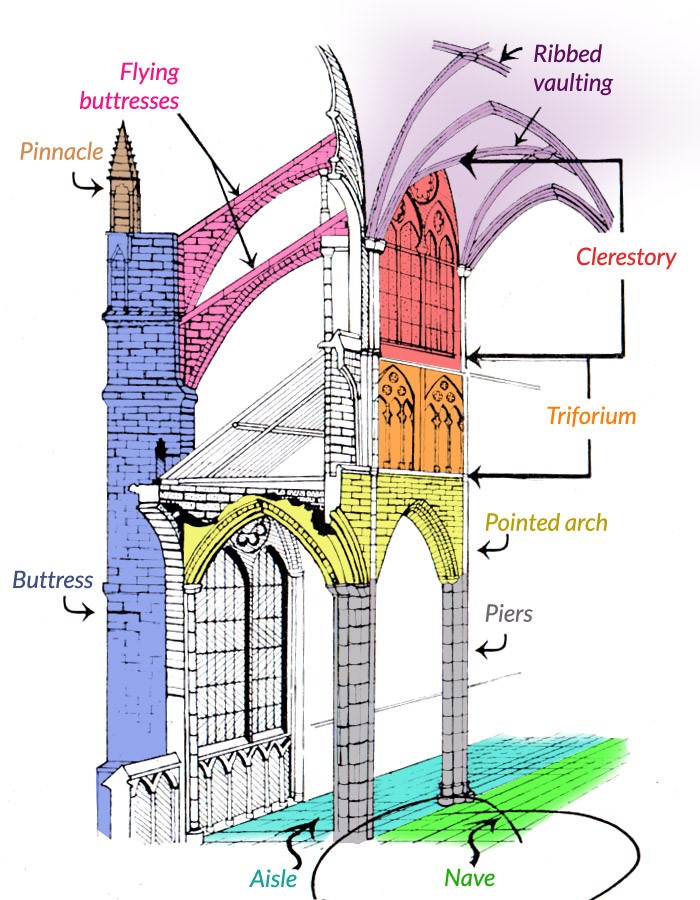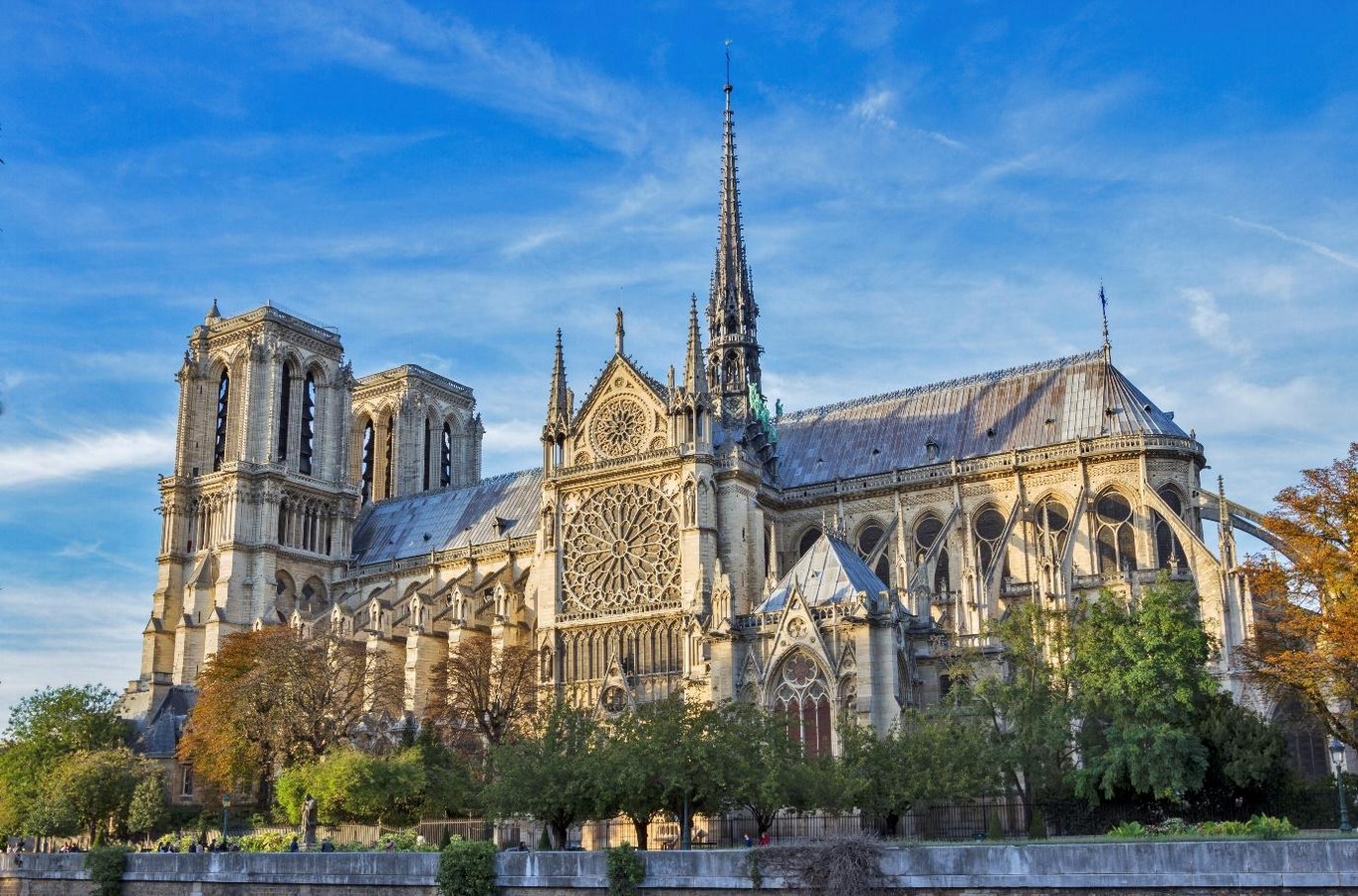Gothic architecture is a defining style of the medieval period that flourished in Europe during the 12th century. Gothic Architectural style evolved from Romanesque architecture and was succeeded by Renaissance architecture. It left an indelible mark on the architectural landscape of the European continent. The awe-inspiring cathedrals, churches, and castles built in the Gothic style showcased their creators’ artistic genius and reflected the cultural, religious, and societal changes of the era. This article delves into the influence of Gothic architecture on medieval Europe, exploring its key characteristics and lasting impact.
Architectural Innovations
Gothic architecture, also known as Opus Francigenum (Latin for “French work”), emerged in 12th-century France and continued to evolve until the 16th century. This architectural style was characterised by innovative engineering techniques that enabled the construction of massive structures. Key innovations included the rib vault, which evolved from Romanesque joint vaulting, the flying buttress, and the pointed (Gothic) arch. These advancements addressed the challenge of constructing tall buildings while maximising natural light. Stained-glass window panels created stunning interior effects with sunlight filtering through. Gothic architecture introduced several distinct features that set it apart from earlier medieval and Classical styles. These features included piers with clusters of colonettes, pinnacles, gables, rose windows, and openings divided into multiple lancet-shaped sections.

Gothic architecture became renowned for its application in Europe’s grand cathedrals, abbeys, and churches. It also extended to castles, palaces, town halls, guild halls, universities, and, to a lesser extent, private dwellings. However, its most significant impact was felt in the construction of great churches and cathedrals, as well as civic buildings. The emotional appeal of Gothic design resonated strongly, whether it was in religious or civic contexts. This era left behind numerous ecclesiastical buildings, many of which hold architectural significance. Notably, several larger churches are considered priceless works of art and have been designated as UNESCO World Heritage Sites. Consequently, the study of Gothic architecture often focuses primarily on cathedrals and churches, which exemplify the style’s most impressive achievements.
Spiritual Symbolism
Gothic architecture, known for its spiritual symbolism, embodies the essence of religious devotion. The Gothic style, primarily associated with religious structures, represents a meticulously coordinated form of the physical church, believed to be God’s dwelling on Earth. The vertical and horizontal dimensions of Gothic churches, filled with luminous light symbolising God’s grace, exemplify the essence of Christian architecture.

Cathedrals served as community focal points, signifying the Church’s power and magnificence. Through intricate stained glass windows portraying biblical tales and heavenly scenes, a sense of divine transcendence was evoked—the soaring heights of these cathedrals aimed at inspiring awe and directing people’s attention towards the heavens. Gothic architecture’s geographical expansion paralleled the influence of the Catholic Church, which dominated Europe during that era, shaping not only religious beliefs but also wealth and power. The growth of monasticism in the medieval period, with orders such as the Franciscans founded by St. Francis of Assisi and the Dominicans established by St. Dominic, played a significant role in constructing Italy‘s Gothic churches.

Regional Variations
Gothic architecture in Europe exhibited regional variations influenced by various factors. The French Gothic style, seen in the Notre Dame Cathedral, featured intricate sculptures and elaborate rose windows. In contrast, the English Gothic style, exemplified by Westminster Abbey, emphasised verticality and elegant simplicity. German Gothic architecture showcased rich ornamentation and delicate tracery, as exemplified in the Cologne Cathedral.

The origins of regional variations can be traced back to the widespread Romanesque period (10th-13th centuries) when Romanesque architecture prevailed across Europe. The acceptance and expression of the Gothic style varied due to geographical, geological, economic, social, and political influences. As a result, distinct regional differences emerged in the design and construction of abbey churches and cathedrals during the Romanesque and Gothic periods.
The availability of local materials significantly influenced construction techniques and architectural styles. France had ample supplies of various limestone grades, with Caen’s fine white limestone favoured for sculptural decoration. England utilised coarse limestone, red sandstone, and dark green Purbeck marble for architectural features. In regions like northern Germany, the Netherlands, northern Poland, Denmark, and the Baltic countries, the scarcity of local building stone led to a distinctive tradition of brick construction known as Brick Gothic or Backsteingotik.
Timber availability also shaped architectural styles, particularly in Scandinavia, where timber buildings prevailed. Throughout Europe, the availability of timber impacted roof construction methods. For instance, England’s magnificent hammer-beam roofs evolved as a response to the depletion of long, straight, seasoned timber by the end of the medieval period, as forests were extensively used for roof construction and shipbuilding.
Furthermore, the availability of specific materials, such as marble in Italy, influenced the facing of buildings. Italy’s abundant and diverse marble deposits led to marble facing in some structures, while others were left with undecorated facades, allowing for future decorative additions. These regional variations in Gothic architecture reflect the interplay between local resources, cultural preferences, and historical circumstances, resulting in a rich tapestry of diverse styles across Europe.
Societal Impact
Gothic architecture was not solely a religious expression but also a reflection of the societal changes occurring in medieval Europe. The construction of grand cathedrals required significant resources, which spurred economic growth and trade. Skilled craftsmen, including stone masons and stained-glass artisans, formed guilds and gained social prominence. Moreover, the communal effort required for such massive construction projects fostered a sense of civic pride and unity among towns and cities.
Conclusion
Gothic architecture is a testament to medieval Europe’s ingenuity and artistic brilliance. Its innovative techniques, spiritual symbolism, and societal impact forever shaped the continent’s architectural landscape. The soaring spires, intricate tracery, and grandeur of Gothic buildings continue to inspire awe and admiration, reminding us of the rich cultural heritage left behind by our medieval ancestors.
Online Sources:
Overstreet, K. (2022). The Origins and Evolution of Gothic Architecture. [online] ArchDaily. Available at: https://www.archdaily.com/983605/the-origins-and-evolution-of-gothic-architecture.
Spanswick, V. (2020). Gothic architecture: an introduction (article) | Khan Academy. [online] Khan Academy. Available at: https://www.khanacademy.org/humanities/medieval-world/gothic-art/beginners-guide-gothic-art/a/gothic-architecture-an-introduction.
HiSoUR – Hi So You Are. (2018). History and influences of Gothic architecture. [online] Available at: https://www.hisour.com/history-and-influences-of-gothic-architecture-29082/.
The Editors of Encyclopedia Britannica (2017). Gothic architecture. In: Encyclopædia Britannica. [online] Available at: https://www.britannica.com/art/Gothic-architecture.
Image Source:
01_ Interior and Exterior Elements: Ayerbe, C. (2013). What is a gothic cathedral? | Cultural Travel Guide. [online] Cultural Travel Guide. Available at: http://www.culturaltravelguide.com/what-is-a-gothic-cathedral.
02_ Notre Dame de Paris: Wikipedia. (2022). Notre-Dame de Paris. [online] Available at: https://en.wikipedia.org/wiki/Notre-Dame_de_Paris#/media/File:Notre-Dame_de_Paris.
03_ Basilica of Saint Francis of Assisi: Italy church: Wikipedia. (2023). Basilica of Saint Francis of Assisi. [online] Available at: https://en.wikipedia.org/wiki/Basilica_of_Saint_Francis_of_Assisi#/media/File:Assisi_San_Francesco_BW_2.JPG [Accessed 19 May 2023].
04_ Cologne Cathedral Window: Wikipedia. (2023). Cologne Cathedral Window. [online] Available at: https://en.wikipedia.org/wiki/Cologne_Cathedral_Window#/media/File:K%C3%B6lner_Dom_-_Richterfenster_an_der_S%C3%BCdseite_bei_Nacht_(7264-66).jpg [Accessed 19 May 2023].















